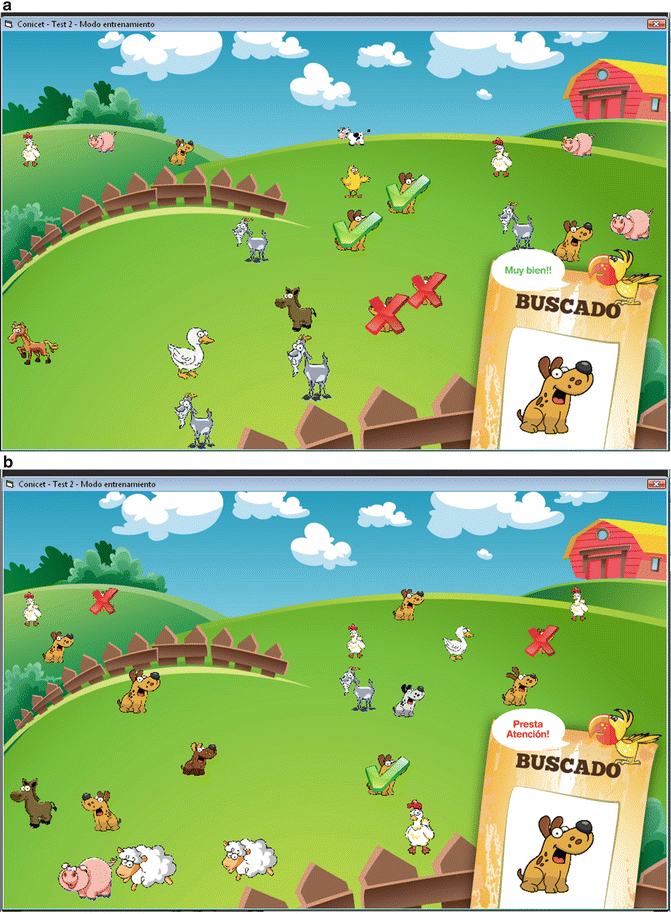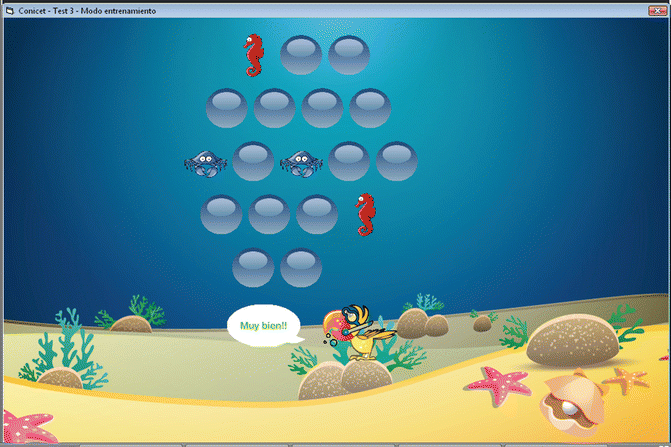Fig. 18.1
(a) Attentional focus test when the correct stimulus has been chosen. (b) Attentional focus test when the incorrect stimulus has been chosen
If that new figure is different from the cue, the child will click “no”, and the sequence described above will ensue.
If the child makes the wrong choice, a different sound will signal the mistake and the bird will say “presta más atención” (pay more attention) (See Fig. 18.1b).
Examples of Test 2
This task consists of searching and selecting the stimulus that is identical to the cue which, in this case, appears as “buscado” (wanted). It presents two categories of stimuli: (1) a farm with animals, and (2) a city with cars.
The task consists of looking for similarities and identifying differences within a broad and varied stimulus field. The screen shows a farm with different animals among which one is the key stimulus. The child needs to click on the animal that is identical to the “buscado” (wanted) cue. A green tick will appear on the animal when the choice is correct, followed by the corresponding sound, and the bird will say “muy bien” (very good) (See Fig. 18.2a).


Fig. 18.2
(a) Focused and sustained attention test, right choice. (b) Focused and sustained attention test, wrong choice
If the child happens to select the wrong animal, a red cross will appear on the animal, followed by a sound that will indicate that the choice was incorrect, and the bird will say “presta atención” (pay attention) (See Fig. 18.2b).
Examples of Test 3
This test is based on the “memo test” game logic. A series of bubbles appear, and when children click on them, a stimulus pops up, sea animals in this particular case. And the task consists of finding the pair for each animal. If the correct pairs are found, the bird will say “muy bien” (very good), or else “presta atención” (pay attention). This is the most complex test because the child needs to remember where a certain stimulus is in order to find the corresponding pair, a task that requires not only concentration but also working memory. When both stimuli are matched, they will remain on display on the screen as the child looks for the other animal pairs (See Fig. 18.3).


Fig. 18.3
Sustained attention and working memory test
For all tests, the program keeps record of the right and wrong choices and the omissions, as well as of the total time used to complete the task. It also keeps a record of the stimuli to which the child was exposed, the number of correct and wrong choices and omissions—stated in raw scores and percentages—and the total time needed for the completion of the task. Finally, a graph showing the performance of each child appears on the right. It shows the results of the tests (See Fig. 18.4).


Fig. 18.4
Individual information record. The program records the child’s personal data, in addition to information about the school, diagnosis, and date
Conclusions
Starting school poses new challenges for children, which involve developing a series of cognitive, emotional and social skills.
In order to adapt to the school context and achieve learning goals, school children need to deal with conflicts and organize their behavior according to working goals, plans, and rules. During the first years of school, children will only be able to achieve these goals under the teachers’ guidance. However, they will gradually internalize cognitive strategies, routines, and habits that will enable them to gain autonomy when managing behavior and learning. In other words, they will need to begin to control their own behavior to better respond to contextual demands.
In this regard, attentional control has been found to be an important component of self-regulation [2].
The results obtained by our team show that intervention programs have greater effectiveness if applied to small groups of school children, and greater recovery of attention is achieved if stimulation starts at earlier ages. Additionally, greater effectiveness is attained if such programs are implemented systematically and sustained over time, with greater probabilities for them to help all children to develop cognitive and socioaffective skills that may enhance their educational opportunities.
If we consider executive attention to be a system involved in the voluntary control of actions, the benefits of attentional training could also extend to the cognitive and emotional regulation manifested in children’s behavior [2, 27, 36].
Finally, the intervention program presented in this chapter finds its rationale in the interplay of the school child, the classroom context, and the child’s family. Therefore, in addition to providing specific tools to effectively interact with children, the joint effort of parents and teachers promotes greater commitment to, and cooperation with, the teaching−learning process.
Acknowledgement
I would like to thank all the members of my research team for their invaluable contributions: Gabriela Morelato, Carolina Greco, Celina Korzeniowski, Adriana Espósito, Mariana Carrada, Silvina Maddio and Cecilia Moreno. Translated by Paola Puppato and Victoria Magariños, of Source & Target.
Stay updated, free articles. Join our Telegram channel

Full access? Get Clinical Tree




